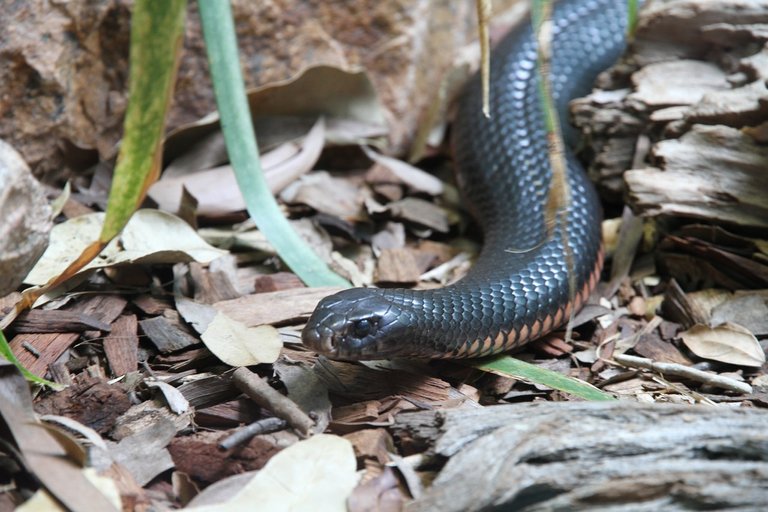Venomous Symphony: The Inland Taipan Venom
If you are walking in the forest in Nigeria, one thing you would be scared of are Snakes from the Cobra, to the viper and this is due to their toxins released from their poison but this cannot be compared to walking in Australia. You hear that most of the deadly animals are found in Australia and sure the Inland Taipan is one of those deadly animals, infact it is one of the most venomous snake, infact some people refer to it as the most venomous snake in the world. So let's discuss this snake in this post.
Found in cracking clay and cracking loam of flooding plain, the Inland Taipan is very lethal. Based on its LD50 lethality rating, it is 72 times deadly than the king cobra where a bite from the king cobra releases about 420 milligrams of venom which can kill 3000 mice, the Inland taipan snake releases 44mg of venom in one bite but that venom can kill about 200 thousand mice.
Before the treatment for the Inland Taipan venom, a single bite from the snake had no antidote but even till now, if an inland taipan snake bites a person, it can lead to permanent damage if an antivenom isn't given in about 45 minutes. If a person doesn't get the antivenom, the person can suffer bleeding from the wound bite and die but before the wound bleed kills him, he is going to suffer kidney failure, respiratory failure, paralysis, and this can lead to death.
Scientists have been studying the methods at which snakes kill their prey in relations to their habitat. Snakes that constricts are found in jungles and environments that are dense since they can ambush their prey but in places where there is a clear and open plain and savannas snakes needed to pursue their preys and use venom. The venom is made of a cocktail of toxins which can help them paralyze and kill the prey and also start the first process of digestion.
Taking a look at the Black mamba, predominant in Africa and the Coastal Taipan are both members of the Elapid genus, and although the have similarities, their venoms components are different. The Black mamba venom is a combination of Kunitz type peptide toxins and three finger alpha neurotoxins while the Coastal Taipan is made of Kunitz type peptides toxins and Beta neurotoxins. These toxins work differently and their venoms are meant to do the same thing in different way based on their location.
The effect of location is even visible among Taipans. Let's take a look at Taipans in Australia as an example. The Central Range Taipan found in the mountains, the Coastal Taipan, and the Inland Taipan are almost the same even with the name Taipan, but they have a few variation in their venom composition. The central range Taipan is made up of three finger alpha neurotoxins, the Coastal Taipan made up of 3 finger phospholipase beta neurotoxin, while the Inland Taipan venom has a combination of both neurotoxins.
The venom of the Inland Taipan possesses lots of organic enzymes and compounds that would help it kill its prey, such enzyme is the Metailoprotease which breaks down protein in blood vessel, and loses the walls of the capillaries and increases inflammation. Another enzyme present in the venom is the Hyaluronidase which increases the rate of absorption of the venom into the blood vessels.
Additionally, the venom contains hemotoxins, causing rapid blood clotting in small amounts and preventing clotting in larger volumes. Nephrotoxins damage kidneys, myotoxins harm muscle tissues, and neurotoxins, such as alpha and beta toxins, induce paralysis. Paradoxin, a slow but lethal enzymatic protein, acts on cell membranes, leading to paralysis and death. Timely administration of antivenom within 30 minutes of a bite can avert this deadly cascade.
The Inland Taipan stands as a testament to the potent weaponry evolved by snakes for survival. Its venom, a complex blend of toxins, reflects the intricate adaptations that make it a formidable predator in Australia's wild terrains.
Reference
https://australian.museum/learn/animals/reptiles/inland-taipan/
https://www.billabongsanctuary.com.au/inland-taipan/
https://www.bionity.com/en/encyclopedia/Inland_Taipan.html
https://www.ncbi.nlm.nih.gov/pmc/articles/PMC4113736/
https://www.sciencedirect.com/topics/pharmacology-toxicology-and-pharmaceutical-science/black-mamba
https://www.ncbi.nlm.nih.gov/pmc/articles/PMC6266942/
https://www.ncbi.nlm.nih.gov/pmc/articles/PMC7546081/
https://www.sciencedirect.com/science/article/abs/pii/0041010179902459
https://www.jstor.org/stable/2408300?seq=1
https://www.mdpi.com/1424-2818/12/3/100
https://zslpublications.onlinelibrary.wiley.com/doi/10.1111/j.1469-7998.2000.tb00823.x
https://www.jstor.org/stable/3892954
https://pubmed.ncbi.nlm.nih.gov/28927001/
https://www.biorxiv.org/content/10.1101/378141v2
https://minerva-access.unimelb.edu.au/items/9da5d488-f6f8-5e2e-85a3-5b774605e6a0
https://www.cell.com/biophysj/fulltext/S0006-3495(15)03404-9


Thanks for your contribution to the STEMsocial community. Feel free to join us on discord to get to know the rest of us!
Please consider delegating to the @stemsocial account (85% of the curation rewards are returned).
Thanks for including @stemsocial as a beneficiary, which gives you stronger support.